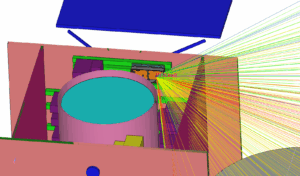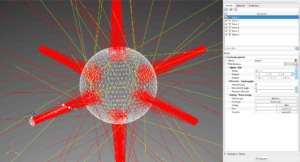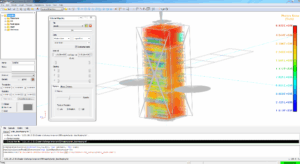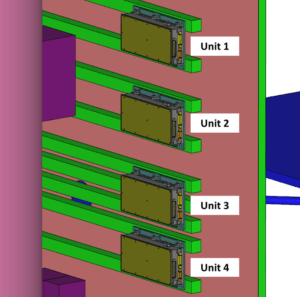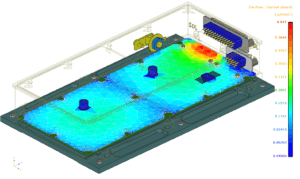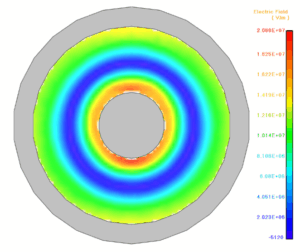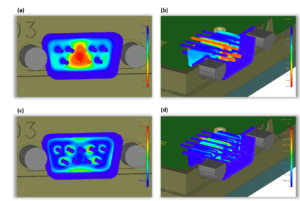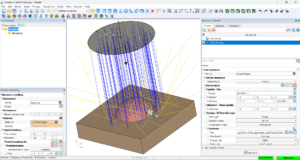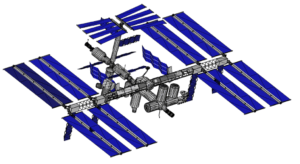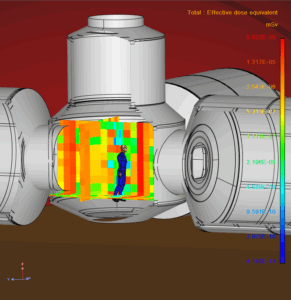FASTRAD® Modules, discover all the functionalities:
Interface and Modeling
Create and handle 3D radiation models, import, export and modify entire STEP models
- Framework: menus, toolbar buttons, property dialog boxes, hierarchy tree
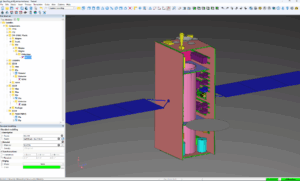
- 2D/3D viewer and easy object handling (rotation, translation, etc.)
- Insertion of simple shapes (box, cylinder, cake, sphere, …)
- Hollow out and merge operations on all shapes (including STEP) for creating complex shapes
- Material definition interface with a database
Sector analysis
Perform essential calculations by sector analysis (ray-tracing), calculate six face equivalent thickness, post-process results to optimize shielding
Calculation by sector analysis can be performed on any FASTRAD® model containing simple and complex shapes.
Ray-tracing calculation tool capabilities include:
- Single or multi-environments definition
- Estimation of various quantities : TID, TNID, current, custom
- Isolated detectors or 2D/3D mappings
- Two calculation methods : slant path or minimum path
- Multi-threading option
- Optimized and/or detailed post-processing file
Monte Carlo calculations & Scripting module
FASTRAD® gives you the keys to the most precise tool, the Monte Carlo particle transport calculation. Both Forward and Reverse methods are available. This tool provides dose, flux and charge deposition outputs
The Monte Carlo particle transport is based on the tracking of particle interactions with matter, based on the interaction cross sections. It considers material composition and particle behavior, allowing to get a higher level of accuracy. Calculation can be run on several threads (parallelization) to increase calculation speed.
The precision of the Forward Monte-Carlo tool can also be increased by adding the hadronic physics add-on. This allows for a better precision for the tracking of high energy protons and is compulsory for the tracking of heavy ions.
The scripting module allows to customize and optimize the use of FASTRAD® by interacting with the main FASTRAD® entities through scripts.
This module allows to perform calculations using a Forward Monte Carlo algorithm. Primary electrons, protons and photons as well as secondary electrons, positrons and photons can be considered with the standard tool. When the hadronic physics add-on in installed, other particles (heavy ions, neutrons, …) are also tracked.
Several sources of particles can be defined at the same time. A wide range of source geometries can be defined, based on the model geometry or from virtual shapes.
Particle trajectories can be visualized and interaction properties are displayed when a track is selected (Figure 4).
The 3D mapping module allows calculation of deposited energies, transmitted integral flux and associated errors in sensitive zones previously specified. With this tool, critical zones can easily be identified (Figure 5).
Internal Charging
By using FASTRAD®, the same geometry used for the dose analysis can be used for the internal charging analysis. The Reverse Monte Carlo method allows to consider the real geometry of the spacecraft while maintaining a reasonable calculation time.
The 3D internal charging analysis in FASTRAD® relies on two types of simulation: Monte Carlo particle transport, for current density and charge deposition calculation and Finite Element Analysis (FEA), for potential and electric field calculation. For the latter, the two methods need to be coupled.
The calculation of the incident current density, by using the Reverse Monte Carlo method, allows to rapidly identify an element potentially sensitive to electrostatic discharge, like coaxial cables, PCB or connectors, among several units.
A surface mapping can be used to get the incident current density on a surface.
Point detectors can also be used, to get the incident current density at a specific location. The current density is estimated for a field of view of 180° on the external face on which the point detector is placed. This is only available by using the Reverse Monte Carlo method.
Radiation Protection
From low Earth orbit to space exploration missions, radiation stands out as a critical element to ensure the health and security of crews.



